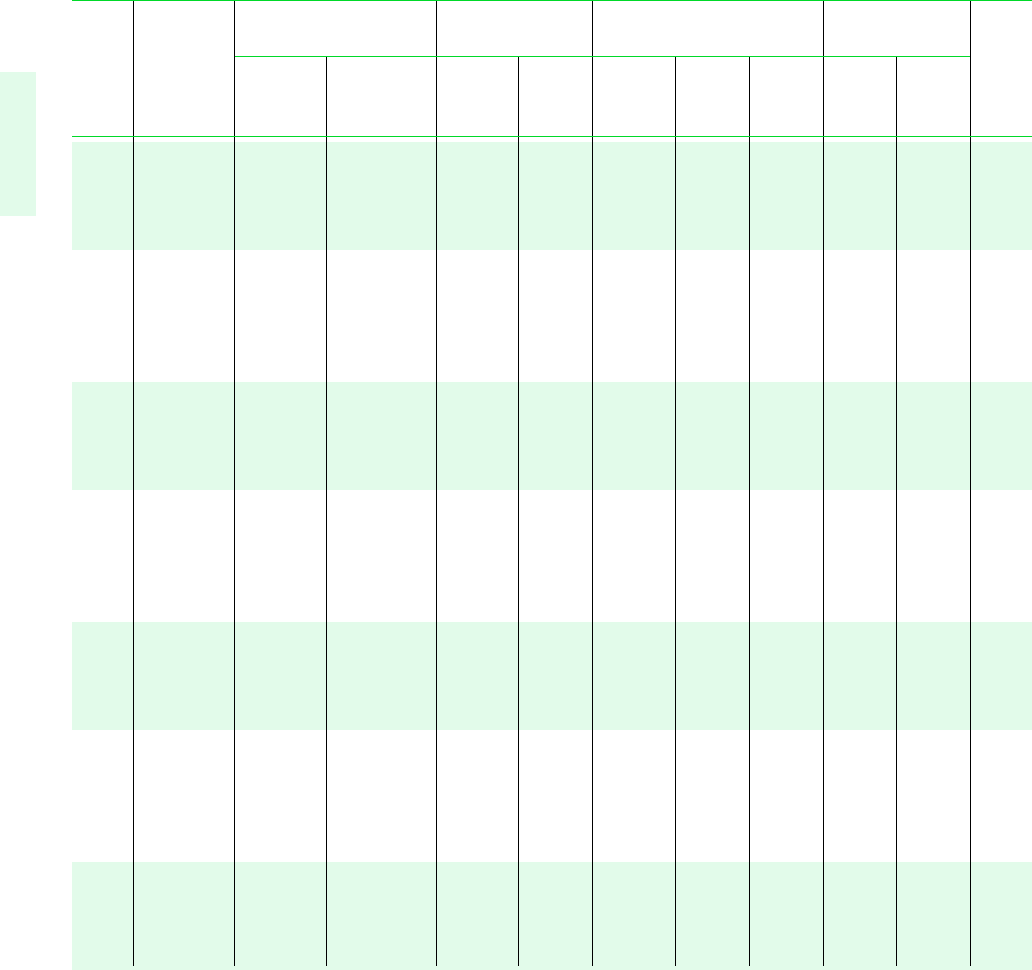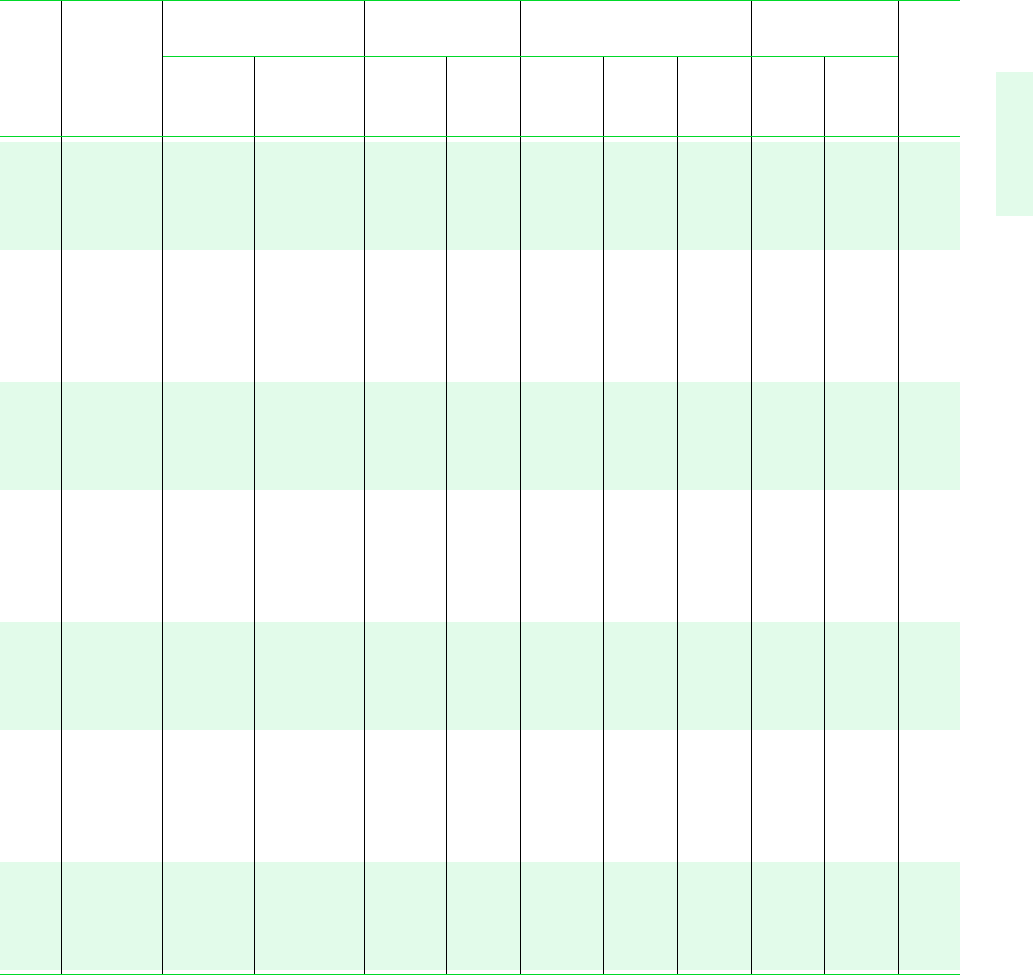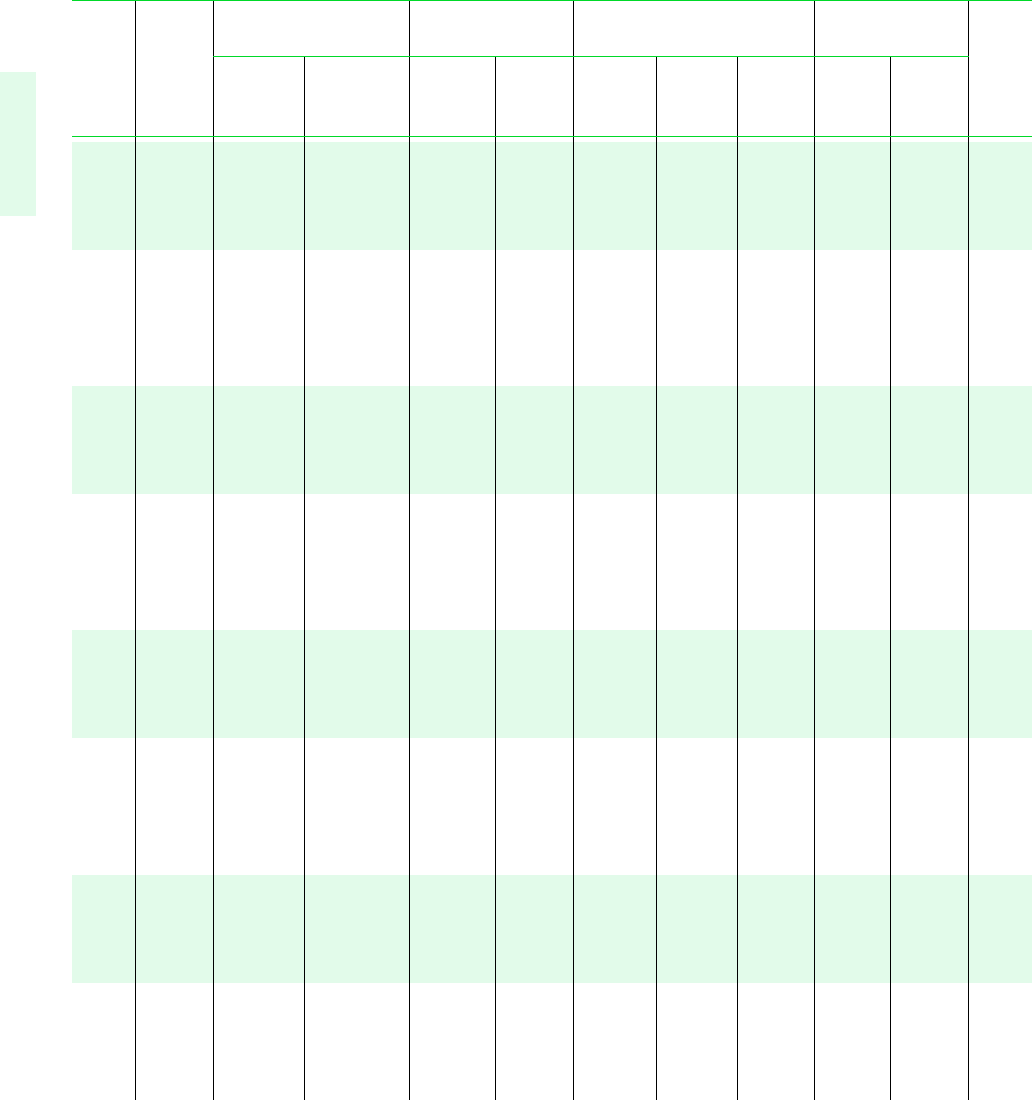Moran M.J., Shapiro H.N. Fundamentals of Engineering Thermodynamics
Подождите немного. Документ загружается.


716 Chapter 14 Chemical and Phase Equilibrium
14.68 Apply the result of Problem 14.84 to determine the num-
ber of degrees of freedom for the gas phase reaction:
14.69 For a gas–liquid system in equilibrium at temperature T
and pressure p, Raoult’s law models the relation between the
partial pressure of substance i in the gas phase, p
i
, and the mole
fraction of substance i in the liquid phase, y
i
, as follows:
where p
sat,i
(T ) is the saturation pressure of pure i at tempera-
ture T. The gas phase is assumed to form an ideal gas mixture;
p
i
y
i
p
sat,i
1T 2
CH
4
H
2
O
S
d
CO 3H
2
thus, p
i
x
i
p where x
i
is the mole fraction of i in the gas phase.
Apply Raoult’s law to the following cases, which are
representative of conditions that might be encountered in
ammonia–water absorption systems (Sec. 10.5):
(a) Consider a two-phase, liquid–vapor ammonia–water
system in equilibrium at 20C. The mole fraction of
ammonia in the liquid phase is 80%. Determine the
pressure, in bar, and the mole fraction of ammonia in the
vapor phase.
(b) Determine the mole fractions of ammonia in the liquid and
vapor phases of a two-phase ammonia–water system in
equilibrium at 40C, 12 bar.
Design & Open Ended Problems: Exploring Engineering Practice
14.1D Using appropriate software, develop plots giving the
variation with equivalence ratio of the equilibrium products of
octane–air mixtures at 30 atm and selected temperatures rang-
ing from 1700 to 2800 K. Consider equivalence ratios in the
interval from 0.2 to 1.4 and equilibrium products including,
but not necessarily limited to, CO
2
, CO, H
2
O, O
2
,O,H
2
,N
2
,
NO, OH. Under what conditions is the formation of nitric oxide
(NO) and carbon monoxide (CO) most significant? Discuss.
14.2D Spark-ignition engine exhaust gases contain several air
pollutants including the oxides of nitrogen, NO and NO
2
, col-
lectively known as NO
x
. Additionally, the exhaust gases may
contain carbon monoxide (CO) and unburned or partially
burned hydrocarbons (HC).
(a) The pollutant amounts actually present depend on engine
design and operating conditions, and typically differ sig-
nificantly from values calculated on the basis of chemical
equilibrium. Discuss both the reasons for these discrepan-
cies and possible mechanisms by which such pollutants are
formed in an actual engine.
(b) For spark-ignition engines, the average production of pol-
lutants upstream of the catalyst, in g per mile of vehicle
travel, are nitric oxides, 1.5; hydrocarbons, 2; and carbon
monoxide, 20. For a city in your locale having a popula-
tion of 100,000 or more, estimate the annual amount, in
kg, of each pollutant that would be discharged if automo-
biles had no emission control devices. Repeat if the
vehicles adhere to current U.S. government emissions
standards.
14.3D The Federal Clean Air Act of 1970 and succeeding Clean
Air Act Amendments target the oxides of nitrogen NO and
NO
2
, collectively known as NO
x
, as significant air pollutants.
NO
x
is formed in combustion via three primary mechanisms:
thermal NO
x
formation, prompt NO
x
formation, and fuel NO
x
formation. Discuss these formation mechanisms, including a
discussion of thermal NO
x
formation by the Zeldovich mech-
anism. What is the role of NO
x
in the formation of ozone? What
are some NO
x
reduction strategies?
14.4D The amount of sulfur dioxide (SO
2
) present in off gases
from industrial processes can be reduced by oxidizing the SO
2
to SO
3
at an elevated temperature in a catalytic reactor. The
SO
3
can be reacted in turn with water to form sulfuric acid that
has economic value. For an off gas at 1 atm having the molar
analysis of 12% SO
2
, 8% O
2
, 80% N
2
, estimate the range of
temperatures at which a substantial conversion of SO
2
to SO
3
might be realized.
14.5D A gaseous mixture of hydrogen (H
2
) and carbon monox-
ide (CO) enters a catalytic reactor and a gaseous mixture of
methanol (CH
3
OH), hydrogen, and carbon monoxide exits. At
the preliminary process design stage, a plausible estimate is
required of the inlet hydrogen mole fraction, the temper-
ature of the exiting mixture, T
e
, and the pressure of the exiting
mixture, p
e
, subject to the following four constraints: (1)
0.5 0.75, (2) 300 T
e
400 K, (3) 1 p
e
10
atm, and (4) the exiting mixture contains at least 75% methanol
on a molar basis. Obtain this estimate.
14.6D When systems in thermal, mechanical, and chemical equi-
librium are perturbed, changes within the systems can occur
leading to a new equilibrium state. The effects of perturbing the
system considered in developing Eqs. 14.32 and 14.33 can be
determined by study of these equations. For example, at fixed
pressure and temperature it can be concluded that an increase in
the amount of the inert component E would lead to increases in
n
C
and n
D
when (
C
D
A
B
) is positive, to
decreases in n
C
and n
D
when is negative, and no change when
0.
(a) For a system consisting of NH
3
,N
2
, and H
2
at fixed pres-
sure and temperature, subject to the reaction
investigate the effects, in turn, of additions in the amounts
present of NH
3
,H
2
, and N
2
.
(b) For the general case of Eqs. 14.32 and 14.33, investigate
the effects, in turn, of additions of A, B, C, and D.
2NH
3
1g2 N
2
1g2 3H
2
1g2
y
H
2
y
H
2
,

Problems: Developing Engineering Skills 717
14.7D With reference to the equilibrium constant data of
Table A-27:
(a) For each of the tabulated reactions plot log
10
K versus 1T
and determine the slope of the line of best fit. What is
the thermodynamic significance of the slope? Check your
conclusion about the slope using data from the JANAF
tables.
2
(b) A text states that the magnitude of the equilibrium con-
stant often signals the importance of a reaction, and offers
this rule of thumb: When K 10
3
, the extent of the re-
action is usually not significant, whereas when K 10
3
the reaction generally proceeds closely to equilibrium.
Confirm or deny this rule.
14.8D (a) For an equilibrium ideal gas mixture of N
2
,H
2
, and
NH
3
, evaluate the equilibrium constant from an expression you
derive from the van’t Hoff equation that requires only standard
state enthalpy of formation and Gibbs function of formation
data together with suitable analytical expressions in terms of
temperature for the ideal gas specific heats of N
2
,H
2
,NH
3
.
(b) For the synthesis of ammonia by
provide a recommendation for the ranges of temperature and
pressure for which the mole fraction of ammonia in the mix-
ture is at least 0.5.
14.9D U.S. Patent 5,298,233 describes a means for converting
industrial wastes to carbon dioxide and water vapor. Hydrogen-
and carbon-containing feed, such as organic or inorganic
sludge, low-grade fuel oil, or municipal garbage, is introduced
into a molten bath consisting of two immiscible molten metal
phases. The carbon and hydrogen of the feed are converted,
respectively, to dissolved carbon and dissolved hydrogen. The
dissolved carbon is oxidized in the first molten metal phase to
carbon dioxide, which is released to the atmosphere. The dis-
solved hydrogen migrates to the second molten metal phase,
where it is oxidized to form water vapor, which is also released
from the bath. Critically evaluate this technology for waste dis-
posal. Is the technology promising commercially? Compare
with alternative waste management practices such as pyroly-
sis and incineration.
14.10D Iceland Aims to be Fossil-fuel Free (see box
Sec. 14.2). Investigate the feasibility of large-scale production
of hydrogen using solar energy and windpower, considering
technical and economical aspects. Write a report including at
least three references.
1
2
N
2
3
2
H
2
S NH
3
2
Stull, D. R., and H. Prophet, JANAF Thermochemical Tables, 2nd ed.,
NSRDS-NBS 37, National Bureau of Standards, Washington, DC, June
1971.

TABLE A-1 Atomic or Molecular Weights and Critical Properties of Selected Elements and Compounds 719
TABLE A-2 Properties of Saturated Water (Liquid–Vapor): Temperature Table 720
TABLE A-3 Properties of Saturated Water (Liquid–Vapor): Pressure Table 722
TABLE A-4 Properties of Superheated Water Vapor 724
TABLE A-5 Properties of Compressed Liquid Water 728
TABLE A-6 Properties of Saturated Water (Solid–Vapor): Temperature Table 729
TABLE A-7 Properties of Saturated Refrigerant 22 (Liquid–Vapor): Temperature Table 730
TABLE A-8 Properties of Saturated Refrigerant 22 (Liquid–Vapor): Pressure Table 731
TABLE A-9 Properties of Superheated Refrigerant 22 Vapor 732
TABLE A-10 Properties of Saturated Refrigerant 134a (Liquid–Vapor): Temperature Table 736
TABLE A-11 Properties of Saturated Refrigerant 134a (Liquid–Vapor): Pressure Table 737
TABLE A-12 Properties of Superheated Refrigerant 134a Vapor 738
TABLE A-13 Properties of Saturated Ammonia (Liquid–Vapor): Temperature Table 741
TABLE A-14 Properties of Saturated Ammonia (Liquid–Vapor): Pressure Table 742
TABLE A-15 Properties of Superheated Ammonia Vapor 743
TABLE A-16 Properties of Saturated Propane (Liquid–Vapor): Temperature Table 747
TABLE A-17 Properties of Saturated Propane (Liquid–Vapor): Pressure Table 748
TABLE A-18 Properties of Superheated Propane Vapor 749
TABLE A-19 Properties of Selected Solids and Liquids: c
p
, , and . 753
TABLE A-20 Ideal Gas Specific Heats of Some Common Gases 754
TABLE A-21 Variation of with Temperature for Selected Ideal Gases 755
TABLE A-22 Ideal Gas Properties of Air 756
TABLE A-23 Ideal Gas Properties of Selected Gases 758
TABLE A-24 Constants for the van der Waals, Redlich–Kwong, and Benedict–Webb–Rubin Equations
of State 762
TABLE A-25 Thermochemical Properties of Selected Substances at 298 K and 1 atm 763
TABLE A-26 Standard Molar Chemical Exergy, (kJ/kmol), of Selected Substances at 298 K and p
0
764
TABLE A-27 Logarithms to the Base 10 of the Equilibrium Constant K 765
e
ch
c
p
718
Index to Tables in SI Units

Tables in SI Units 719
TABLE A-1 Atomic or Molecular Weights and Critical Properties of Selected
Elements and Compounds
Chemical MT
c
p
c
Substance Formula (kg/kmol) (K) (bar)
Acetylene C
2
H
2
26.04 309 62.8 0.274
Air (equivalent) — 28.97 133 37.7 0.284
Ammonia NH
3
17.03 406 112.8 0.242
Argon Ar 39.94 151 48.6 0.290
Benzene C
6
H
6
78.11 563 49.3 0.274
Butane C
4
H
10
58.12 425 38.0 0.274
Carbon C 12.01 — — —
Carbon dioxide CO
2
44.01 304 73.9 0.276
Carbon monoxide CO 28.01 133 35.0 0.294
Copper Cu 63.54 — — —
Ethane C
2
H
6
30.07 305 48.8 0.285
Ethyl alcohol C
2
H
5
OH 46.07 516 63.8 0.249
Ethylene C
2
H
4
28.05 283 51.2 0.270
Helium He 4.003 5.2 2.3 0.300
Hydrogen H
2
2.016 33.2 13.0 0.304
Methane CH
4
16.04 191 46.4 0.290
Methyl alcohol CH
3
OH 32.04 513 79.5 0.220
Nitrogen N
2
28.01 126 33.9 0.291
Octane C
8
H
18
114.22 569 24.9 0.258
Oxygen O
2
32.00 154 50.5 0.290
Propane C
3
H
8
44.09 370 42.7 0.276
Propylene C
3
H
6
42.08 365 46.2 0.276
Refrigerant 12 CCl
2
F
2
120.92 385 41.2 0.278
Refrigerant 22 CHClF
2
86.48 369 49.8 0.267
Refrigerant 134a CF
3
CH
2
F 102.03 374 40.7 0.260
Sulfur dioxide SO
2
64.06 431 78.7 0.268
Water H
2
O 18.02 647.3 220.9 0.233
Sources: Adapted from International Critical Tables and L. C. Nelson and E. F. Obert, Generalized Compressibility
Charts, Chem. Eng., 61: 203 (1954).
Z
c
p
c
v
c
RT
c
Table A-1

720 Tables in SI Units
H
2
O
TABLE A-2 Properties of Saturated Water (Liquid–Vapor): Temperature Table
Specific Volume Internal Energy Enthalpy Entropy
m
3
/kg kJ/kg kJ/kg kJ/kg K
Sat. Sat. Sat. Sat. Sat. Sat. Sat. Sat.
Temp. Press. Liquid Vapor Liquid Vapor Liquid Evap. Vapor Liquid Vapor Temp.
C bar v
f
10
3
v
g
u
f
u
g
h
f
h
fg
h
g
s
f
s
g
C
.01 0.00611 1.0002 206.136 0.00 2375.3 0.01 2501.3 2501.4 0.0000 9.1562 .01
4 0.00813 1.0001 157.232 16.77 2380.9 16.78 2491.9 2508.7 0.0610 9.0514 4
5 0.00872 1.0001 147.120 20.97 2382.3 20.98 2489.6 2510.6 0.0761 9.0257 5
6 0.00935 1.0001 137.734 25.19 2383.6 25.20 2487.2 2512.4 0.0912 9.0003 6
8 0.01072 1.0002 120.917 33.59 2386.4 33.60 2482.5 2516.1 0.1212 8.9501 8
10 0.01228 1.0004 106.379 42.00 2389.2 42.01 2477.7 2519.8 0.1510 8.9008 10
11 0.01312 1.0004 99.857 46.20 2390.5 46.20 2475.4 2521.6 0.1658 8.8765 11
12 0.01402 1.0005 93.784 50.41 2391.9 50.41 2473.0 2523.4 0.1806 8.8524 12
13 0.01497 1.0007 88.124 54.60 2393.3 54.60 2470.7 2525.3 0.1953 8.8285 13
14 0.01598 1.0008 82.848 58.79 2394.7 58.80 2468.3 2527.1 0.2099 8.8048 14
15 0.01705 1.0009 77.926 62.99 2396.1 62.99 2465.9 2528.9 0.2245 8.7814 15
16 0.01818 1.0011 73.333 67.18 2397.4 67.19 2463.6 2530.8 0.2390 8.7582 16
17 0.01938 1.0012 69.044 71.38 2398.8 71.38 2461.2 2532.6 0.2535 8.7351 17
18 0.02064 1.0014 65.038 75.57 2400.2 75.58 2458.8 2534.4 0.2679 8.7123 18
19 0.02198 1.0016 61.293 79.76 2401.6 79.77 2456.5 2536.2 0.2823 8.6897 19
20 0.02339 1.0018 57.791 83.95 2402.9 83.96 2454.1 2538.1 0.2966 8.6672 20
21 0.02487 1.0020 54.514 88.14 2404.3 88.14 2451.8 2539.9 0.3109 8.6450 21
22 0.02645 1.0022 51.447 92.32 2405.7 92.33 2449.4 2541.7 0.3251 8.6229 22
23 0.02810 1.0024 48.574 96.51 2407.0 96.52 2447.0 2543.5 0.3393 8.6011 23
24 0.02985 1.0027 45.883 100.70 2408.4 100.70 2444.7 2545.4 0.3534 8.5794 24
25 0.03169 1.0029 43.360 104.88 2409.8 104.89 2442.3 2547.2 0.3674 8.5580 25
26 0.03363 1.0032 40.994 109.06 2411.1 109.07 2439.9 2549.0 0.3814 8.5367 26
27 0.03567 1.0035 38.774 113.25 2412.5 113.25 2437.6 2550.8 0.3954 8.5156 27
28 0.03782 1.0037 36.690 117.42 2413.9 117.43 2435.2 2552.6 0.4093 8.4946 28
29 0.04008 1.0040 34.733 121.60 2415.2 121.61 2432.8 2554.5 0.4231 8.4739 29
30 0.04246 1.0043 32.894 125.78 2416.6 125.79 2430.5 2556.3 0.4369 8.4533 30
31 0.04496 1.0046 31.165 129.96 2418.0 129.97 2428.1 2558.1 0.4507 8.4329 31
32 0.04759 1.0050 29.540 134.14 2419.3 134.15 2425.7 2559.9 0.4644 8.4127 32
33 0.05034 1.0053 28.011 138.32 2420.7 138.33 2423.4 2561.7 0.4781 8.3927 33
34 0.05324 1.0056 26.571 142.50 2422.0 142.50 2421.0 2563.5 0.4917 8.3728 34
35 0.05628 1.0060 25.216 146.67 2423.4 146.68 2418.6 2565.3 0.5053 8.3531 35
36 0.05947 1.0063 23.940 150.85 2424.7 150.86 2416.2 2567.1 0.5188 8.3336 36
38 0.06632 1.0071 21.602 159.20 2427.4 159.21 2411.5 2570.7 0.5458 8.2950 38
40 0.07384 1.0078 19.523 167.56 2430.1 167.57 2406.7 2574.3 0.5725 8.2570 40
45 0.09593 1.0099 15.258 188.44 2436.8 188.45 2394.8 2583.2 0.6387 8.1648 45
#

Tables in SI Units 721
H
2
O
TABLE A-2 (Continued)
Specific Volume Internal Energy Enthalpy Entropy
m
3
/kg kJ/kg kJ/kg kJ/kg K
Sat. Sat. Sat. Sat. Sat. Sat. Sat. Sat.
Temp. Press. Liquid Vapor Liquid Vapor Liquid Evap. Vapor Liquid Vapor Temp.
C bar v
f
10
3
v
g
u
f
u
g
h
f
h
fg
h
g
s
f
s
g
C
50 .1235 1.0121 12.032 209.32 2443.5 209.33 2382.7 2592.1 .7038 8.0763 50
55 .1576 1.0146 9.568 230.21 2450.1 230.23 2370.7 2600.9 .7679 7.9913 55
60 .1994 1.0172 7.671 251.11 2456.6 251.13 2358.5 2609.6 .8312 7.9096 60
65 .2503 1.0199 6.197 272.02 2463.1 272.06 2346.2 2618.3 .8935 7.8310 65
70 .3119 1.0228 5.042 292.95 2469.6 292.98 2333.8 2626.8 .9549 7.7553 70
75 .3858 1.0259 4.131 313.90 2475.9 313.93 2321.4 2635.3 1.0155 7.6824 75
80 .4739 1.0291 3.407 334.86 2482.2 334.91 2308.8 2643.7 1.0753 7.6122 80
85 .5783 1.0325 2.828 355.84 2488.4 355.90 2296.0 2651.9 1.1343 7.5445 85
90 .7014 1.0360 2.361 376.85 2494.5 376.92 2283.2 2660.1 1.1925 7.4791 90
95 .8455 1.0397 1.982 397.88 2500.6 397.96 2270.2 2668.1 1.2500 7.4159 95
100 1.014 1.0435 1.673 418.94 2506.5 419.04 2257.0 2676.1 1.3069 7.3549 100
110 1.433 1.0516 1.210 461.14 2518.1 461.30 2230.2 2691.5 1.4185 7.2387 110
120 1.985 1.0603 0.8919 503.50 2529.3 503.71 2202.6 2706.3 1.5276 7.1296 120
130 2.701 1.0697 0.6685 546.02 2539.9 546.31 2174.2 2720.5 1.6344 7.0269 130
140 3.613 1.0797 0.5089 588.74 2550.0 589.13 2144.7 2733.9 1.7391 6.9299 140
150 4.758 1.0905 0.3928 631.68 2559.5 632.20 2114.3 2746.5 1.8418 6.8379 150
160 6.178 1.1020 0.3071 674.86 2568.4 675.55 2082.6 2758.1 1.9427 6.7502 160
170 7.917 1.1143 0.2428 718.33 2576.5 719.21 2049.5 2768.7 2.0419 6.6663 170
180 10.02 1.1274 0.1941 762.09 2583.7 763.22 2015.0 2778.2 2.1396 6.5857 180
190 12.54 1.1414 0.1565 806.19 2590.0 807.62 1978.8 2786.4 2.2359 6.5079 190
200 15.54 1.1565 0.1274 850.65 2595.3 852.45 1940.7 2793.2 2.3309 6.4323 200
210 19.06 1.1726 0.1044 895.53 2599.5 897.76 1900.7 2798.5 2.4248 6.3585 210
220 23.18 1.1900 0.08619 940.87 2602.4 943.62 1858.5 2802.1 2.5178 6.2861 220
230 27.95 1.2088 0.07158 986.74 2603.9 990.12 1813.8 2804.0 2.6099 6.2146 230
240 33.44 1.2291 0.05976 1033.2 2604.0 1037.3 1766.5 2803.8 2.7015 6.1437 240
250 39.73 1.2512 0.05013 1080.4 2602.4 1085.4 1716.2 2801.5 2.7927 6.0730 250
260 46.88 1.2755 0.04221 1128.4 2599.0 1134.4 1662.5 2796.6 2.8838 6.0019 260
270 54.99 1.3023 0.03564 1177.4 2593.7 1184.5 1605.2 2789.7 2.9751 5.9301 270
280 64.12 1.3321 0.03017 1227.5 2586.1 1236.0 1543.6 2779.6 3.0668 5.8571 280
290 74.36 1.3656 0.02557 1278.9 2576.0 1289.1 1477.1 2766.2 3.1594 5.7821 290
300 85.81 1.4036 0.02167 1332.0 2563.0 1344.0 1404.9 2749.0 3.2534 5.7045 300
320 112.7 1.4988 0.01549 1444.6 2525.5 1461.5 1238.6 2700.1 3.4480 5.5362 320
340 145.9 1.6379 0.01080 1570.3 2464.6 1594.2 1027.9 2622.0 3.6594 5.3357 340
360 186.5 1.8925 0.006945 1725.2 2351.5 1760.5 720.5 2481.0 3.9147 5.0526 360
374.14 220.9 3.155 0.003155 2029.6 2029.6 2099.3 0 2099.3 4.4298 4.4298 374.14
Source: Tables A-2 through A-5 are extracted from J. H. Keenan, F. G. Keyes, P. G. Hill, and J. G. Moore, Steam Tables, Wiley, New York, 1969.
#

722 Tables in SI Units
TABLE A-3 Properties of Saturated Water (Liquid–Vapor): Pressure Table
Specific Volume Internal Energy Enthalpy Entropy
m
3
/kg kJ/kg kJ/kg kJ/kg K
Sat. Sat. Sat. Sat. Sat. Sat. Sat. Sat.
Press. Temp. Liquid Vapor Liquid Vapor Liquid Evap. Vapor Liquid Vapor Press.
bar C v
f
10
3
v
g
u
f
u
g
h
f
h
fg
h
g
s
f
s
g
bar
0.04 28.96 1.0040 34.800 121.45 2415.2 121.46 2432.9 2554.4 0.4226 8.4746 0.04
0.06 36.16 1.0064 23.739 151.53 2425.0 151.53 2415.9 2567.4 0.5210 8.3304 0.06
0.08 41.51 1.0084 18.103 173.87 2432.2 173.88 2403.1 2577.0 0.5926 8.2287 0.08
0.10 45.81 1.0102 14.674 191.82 2437.9 191.83 2392.8 2584.7 0.6493 8.1502 0.10
0.20 60.06 1.0172 7.649 251.38 2456.7 251.40 2358.3 2609.7 0.8320 7.9085 0.20
0.30 69.10 1.0223 5.229 289.20 2468.4 289.23 2336.1 2625.3 0.9439 7.7686 0.30
0.40 75.87 1.0265 3.993 317.53 2477.0 317.58 2319.2 2636.8 1.0259 7.6700 0.40
0.50 81.33 1.0300 3.240 340.44 2483.9 340.49 2305.4 2645.9 1.0910 7.5939 0.50
0.60 85.94 1.0331 2.732 359.79 2489.6 359.86 2293.6 2653.5 1.1453 7.5320 0.60
0.70 89.95 1.0360 2.365 376.63 2494.5 376.70 2283.3 2660.0 1.1919 7.4797 0.70
0.80 93.50 1.0380 2.087 391.58 2498.8 391.66 2274.1 2665.8 1.2329 7.4346 0.80
0.90 96.71 1.0410 1.869 405.06 2502.6 405.15 2265.7 2670.9 1.2695 7.3949 0.90
1.00 99.63 1.0432 1.694 417.36 2506.1 417.46 2258.0 2675.5 1.3026 7.3594 1.00
1.50 111.4 1.0528 1.159 466.94 2519.7 467.11 2226.5 2693.6 1.4336 7.2233 1.50
2.00 120.2 1.0605 0.8857 504.49 2529.5 504.70 2201.9 2706.7 1.5301 7.1271 2.00
2.50 127.4 1.0672 0.7187 535.10 2537.2 535.37 2181.5 2716.9 1.6072 7.0527 2.50
3.00 133.6 1.0732 0.6058 561.15 2543.6 561.47 2163.8 2725.3 1.6718 6.9919 3.00
3.50 138.9 1.0786 0.5243 583.95 2546.9 584.33 2148.1 2732.4 1.7275 6.9405 3.50
4.00 143.6 1.0836 0.4625 604.31 2553.6 604.74 2133.8 2738.6 1.7766 6.8959 4.00
4.50 147.9 1.0882 0.4140 622.25 2557.6 623.25 2120.7 2743.9 1.8207 6.8565 4.50
5.00 151.9 1.0926 0.3749 639.68 2561.2 640.23 2108.5 2748.7 1.8607 6.8212 5.00
6.00 158.9 1.1006 0.3157 669.90 2567.4 670.56 2086.3 2756.8 1.9312 6.7600 6.00
7.00 165.0 1.1080 0.2729 696.44 2572.5 697.22 2066.3 2763.5 1.9922 6.7080 7.00
8.00 170.4 1.1148 0.2404 720.22 2576.8 721.11 2048.0 2769.1 2.0462 6.6628 8.00
9.00 175.4 1.1212 0.2150 741.83 2580.5 742.83 2031.1 2773.9 2.0946 6.6226 9.00
10.0 179.9 1.1273 0.1944 761.68 2583.6 762.81 2015.3 2778.1 2.1387 6.5863 10.0
15.0 198.3 1.1539 0.1318 843.16 2594.5 844.84 1947.3 2792.2 2.3150 6.4448 15.0
20.0 212.4 1.1767 0.09963 906.44 2600.3 908.79 1890.7 2799.5 2.4474 6.3409 20.0
25.0 224.0 1.1973 0.07998 959.11 2603.1 962.11 1841.0 2803.1 2.5547 6.2575 25.0
30.0 233.9 1.2165 0.06668 1004.8 2604.1 1008.4 1795.7 2804.2 2.6457 6.1869 30.0
35.0 242.6 1.2347 0.05707 1045.4 2603.7 1049.8 1753.7 2803.4 2.7253 6.1253 35.0
40.0 250.4 1.2522 0.04978 1082.3 2602.3 1087.3 1714.1 2801.4 2.7964 6.0701 40.0
45.0 257.5 1.2692 0.04406 1116.2 2600.1 1121.9 1676.4 2798.3 2.8610 6.0199 45.0
50.0 264.0 1.2859 0.03944 1147.8 2597.1 1154.2 1640.1 2794.3 2.9202 5.9734 50.0
60.0 275.6 1.3187 0.03244 1205.4 2589.7 1213.4 1571.0 2784.3 3.0267 5.8892 60.0
70.0 285.9 1.3513 0.02737 1257.6 2580.5 1267.0 1505.1 2772.1 3.1211 5.8133 70.0
80.0 295.1 1.3842 0.02352 1305.6 2569.8 1316.6 1441.3 2758.0 3.2068 5.7432 80.0
90.0 303.4 1.4178 0.02048 1350.5 2557.8 1363.3 1378.9 2742.1 3.2858 5.6772 90.0
100. 311.1 1.4524 0.01803 1393.0 2544.4 1407.6 1317.1 2724.7 3.3596 5.6141 100.
110. 318.2 1.4886 0.01599 1433.7 2529.8 1450.1 1255.5 2705.6 3.4295 5.5527 110.
#
H
2
O

Tables in SI Units 723
TABLE A-3 (Continued)
Specific Volume Internal Energy Enthalpy Entropy
m
3
/kg kJ/kg kJ/kg kJ/kg K
Sat. Sat. Sat. Sat. Sat. Sat. Sat. Sat.
Press. Temp. Liquid Vapor Liquid Vapor Liquid Evap. Vapor Liquid Vapor Press.
bar C v
f
10
3
v
g
u
f
u
g
h
f
h
fg
h
g
s
f
s
g
bar
120. 324.8 1.5267 0.01426 1473.0 2513.7 1491.3 1193.6 2684.9 3.4962 5.4924 120.
130. 330.9 1.5671 0.01278 1511.1 2496.1 1531.5 1130.7 2662.2 3.5606 5.4323 130.
140. 336.8 1.6107 0.01149 1548.6 2476.8 1571.1 1066.5 2637.6 3.6232 5.3717 140.
150. 342.2 1.6581 0.01034 1585.6 2455.5 1610.5 1000.0 2610.5 3.6848 5.3098 150.
160. 347.4 1.7107 0.009306 1622.7 2431.7 1650.1 930.6 2580.6 3.7461 5.2455 160.
170. 352.4 1.7702 0.008364 1660.2 2405.0 1690.3 856.9 2547.2 3.8079 5.1777 170.
180. 357.1 1.8397 0.007489 1698.9 2374.3 1732.0 777.1 2509.1 3.8715 5.1044 180.
190. 361.5 1.9243 0.006657 1739.9 2338.1 1776.5 688.0 2464.5 3.9388 5.0228 190.
200. 365.8 2.036 0.005834 1785.6 2293.0 1826.3 583.4 2409.7 4.0139 4.9269 200.
220.9 374.1 3.155 0.003155 2029.6 2029.6 2099.3 0 2099.3 4.4298 4.4298 220.9
#
H
2
O

724 Tables in SI Units
TABLE A-4 Properties of Superheated Water Vapor
T v uh s v uh s
Cm
3
/kg kJ/kg kJ/kg kJ/kg K m
3
/kg kJ/kg kJ/kg kJ/kg K
p 0.06 bar 0.006 MPa p 0.35 bar 0.035 MPa
(T
sat
36.16C) (T
sat
72.69C)
Sat. 23.739 2425.0 2567.4 8.3304 4.526 2473.0 2631.4 7.7158
80 27.132 2487.3 2650.1 8.5804 4.625 2483.7 2645.6 7.7564
120 30.219 2544.7 2726.0 8.7840 5.163 2542.4 2723.1 7.9644
160 33.302 2602.7 2802.5 8.9693 5.696 2601.2 2800.6 8.1519
200 36.383 2661.4 2879.7 9.1398 6.228 2660.4 2878.4 8.3237
240 39.462 2721.0 2957.8 9.2982 6.758 2720.3 2956.8 8.4828
280 42.540 2781.5 3036.8 9.4464 7.287 2780.9 3036.0 8.6314
320 45.618 2843.0 3116.7 9.5859 7.815 2842.5 3116.1 8.7712
360 48.696 2905.5 3197.7 9.7180 8.344 2905.1 3197.1 8.9034
400 51.774 2969.0 3279.6 9.8435 8.872 2968.6 3279.2 9.0291
440 54.851 3033.5 3362.6 9.9633 9.400 3033.2 3362.2 9.1490
500 59.467 3132.3 3489.1 10.1336 10.192 3132.1 3488.8 9.3194
p 0.70 bar 0.07 MPa p 1.0 bar 0.10 MPa
(T
sat
89.95C) (T
sat
99.63C)
Sat. 2.365 2494.5 2660.0 7.4797 1.694 2506.1 2675.5 7.3594
100 2.434 2509.7 2680.0 7.5341 1.696 2506.7 2676.2 7.3614
120 2.571 2539.7 2719.6 7.6375 1.793 2537.3 2716.6 7.4668
160 2.841 2599.4 2798.2 7.8279 1.984 2597.8 2796.2 7.6597
200 3.108 2659.1 2876.7 8.0012 2.172 2658.1 2875.3 7.8343
240 3.374 2719.3 2955.5 8.1611 2.359 2718.5 2954.5 7.9949
280 3.640 2780.2 3035.0 8.3162 2.546 2779.6 3034.2 8.1445
320 3.905 2842.0 3115.3 8.4504 2.732 2841.5 3114.6 8.2849
360 4.170 2904.6 3196.5 8.5828 2.917 2904.2 3195.9 8.4175
400 4.434 2968.2 3278.6 8.7086 3.103 2967.9 3278.2 8.5435
440 4.698 3032.9 3361.8 8.8286 3.288 3032.6 3361.4 8.6636
500 5.095 3131.8 3488.5 8.9991 3.565 3131.6 3488.1 8.8342
p 1.5 bar 0.15 MPa p 3.0 bar 0.30 MPa
(T
sat
111.37C) (T
sat
133.55C)
Sat. 1.159 2519.7 2693.6 7.2233 0.606 2543.6 2725.3 6.9919
120 1.188 2533.3 2711.4 7.2693
160 1.317 2595.2 2792.8 7.4665 0.651 2587.1 2782.3 7.1276
200 1.444 2656.2 2872.9 7.6433 0.716 2650.7 2865.5 7.3115
240 1.570 2717.2 2952.7 7.8052 0.781 2713.1 2947.3 7.4774
280 1.695 2778.6 3032.8 7.9555 0.844 2775.4 3028.6 7.6299
320 1.819 2840.6 3113.5 8.0964 0.907 2838.1 3110.1 7.7722
360 1.943 2903.5 3195.0 8.2293 0.969 2901.4 3192.2 7.9061
400 2.067 2967.3 3277.4 8.3555 1.032 2965.6 3275.0 8.0330
440 2.191 3032.1 3360.7 8.4757 1.094 3030.6 3358.7 8.1538
500 2.376 3131.2 3487.6 8.6466 1.187 3130.0 3486.0 8.3251
600 2.685 3301.7 3704.3 8.9101 1.341 3300.8 3703.2 8.5892
##
H
2
O

Tables in SI Units 725
TABLE A-4 (Continued)
T v uh s v uh s
Cm
3
/kg kJ/kg kJ/kg kJ/kg K m
3
/kg kJ/kg kJ/kg kJ/kg K
p 5.0 bar 0.50 MPa p 7.0 bar 0.70 MPa
(T
sat
151.86C) (T
sat
164.97C)
Sat. 0.3749 2561.2 2748.7 6.8213 0.2729 2572.5 2763.5 6.7080
180 0.4045 2609.7 2812.0 6.9656 0.2847 2599.8 2799.1 6.7880
200 0.4249 2642.9 2855.4 7.0592 0.2999 2634.8 2844.8 6.8865
240 0.4646 2707.6 2939.9 7.2307 0.3292 2701.8 2932.2 7.0641
280 0.5034 2771.2 3022.9 7.3865 0.3574 2766.9 3017.1 7.2233
320 0.5416 2834.7 3105.6 7.5308 0.3852 2831.3 3100.9 7.3697
360 0.5796 2898.7 3188.4 7.6660 0.4126 2895.8 3184.7 7.5063
400 0.6173 2963.2 3271.9 7.7938 0.4397 2960.9 3268.7 7.6350
440 0.6548 3028.6 3356.0 7.9152 0.4667 3026.6 3353.3 7.7571
500 0.7109 3128.4 3483.9 8.0873 0.5070 3126.8 3481.7 7.9299
600 0.8041 3299.6 3701.7 8.3522 0.5738 3298.5 3700.2 8.1956
700 0.8969 3477.5 3925.9 8.5952 0.6403 3476.6 3924.8 8.4391
p 10.0 bar 1.0 MPa p 15.0 bar 1.5 MPa
(T
sat
179.91C) (T
sat
198.32C)
Sat. 0.1944 2583.6 2778.1 6.5865 0.1318 2594.5 2792.2 6.4448
200 0.2060 2621.9 2827.9 6.6940 0.1325 2598.1 2796.8 6.4546
240 0.2275 2692.9 2920.4 6.8817 0.1483 2676.9 2899.3 6.6628
280 0.2480 2760.2 3008.2 7.0465 0.1627 2748.6 2992.7 6.8381
320 0.2678 2826.1 3093.9 7.1962 0.1765 2817.1 3081.9 6.9938
360 0.2873 2891.6 3178.9 7.3349 0.1899 2884.4 3169.2 7.1363
400 0.3066 2957.3 3263.9 7.4651 0.2030 2951.3 3255.8 7.2690
440 0.3257 3023.6 3349.3 7.5883 0.2160 3018.5 3342.5 7.3940
500 0.3541 3124.4 3478.5 7.7622 0.2352 3120.3 3473.1 7.5698
540 0.3729 3192.6 3565.6 7.8720 0.2478 3189.1 3560.9 7.6805
600 0.4011 3296.8 3697.9 8.0290 0.2668 3293.9 3694.0 7.8385
640 0.4198 3367.4 3787.2 8.1290 0.2793 3364.8 3783.8 7.9391
p 20.0 bar 2.0 MPa p 30.0 bar 3.0 MPa
(T
sat
212.42C) (T
sat
233.90C)
Sat. 0.0996 2600.3 2799.5 6.3409 0.0667 2604.1 2804.2 6.1869
240 0.1085 2659.6 2876.5 6.4952 0.0682 2619.7 2824.3 6.2265
280 0.1200 2736.4 2976.4 6.6828 0.0771 2709.9 2941.3 6.4462
320 0.1308 2807.9 3069.5 6.8452 0.0850 2788.4 3043.4 6.6245
360 0.1411 2877.0 3159.3 6.9917 0.0923 2861.7 3138.7 6.7801
400 0.1512 2945.2 3247.6 7.1271 0.0994 2932.8 3230.9 6.9212
440 0.1611 3013.4 3335.5 7.2540 0.1062 3002.9 3321.5 7.0520
500 0.1757 3116.2 3467.6 7.4317 0.1162 3108.0 3456.5 7.2338
540 0.1853 3185.6 3556.1 7.5434 0.1227 3178.4 3546.6 7.3474
600 0.1996 3290.9 3690.1 7.7024 0.1324 3285.0 3682.3 7.5085
640 0.2091 3362.2 3780.4 7.8035 0.1388 3357.0 3773.5 7.6106
700 0.2232 3470.9 3917.4 7.9487 0.1484 3466.5 3911.7 7.7571
##
H
2
O
